Original author: Carol, PANews
BlockRock, the worlds largest asset management company, submitted an application for a Bitcoin spot ETF to the SEC on June 15, although the SEC will respond to the review as early as September 2 (Related reading: PA Illustration - A quick look at each Bitcoin in one chart A critical time point for the review of spot ETF applications), but considering BlackRocks global position in the asset management industry, this news is still considered an important signal, indicating that Bitcoin and other cryptocurrencies may be more adopted by institutions. In addition, well-known institutions that have also recently submitted applications for Bitcoin spot ETFs to the SEC include Fidelity, WisdomTree, VanEck, Invesco Galaxy, etc. As more and more institutions express their willingness to enter the market, the market is confident in ushering in more compliant crypto investment products.
What exactly can institutions bring to the crypto market? To this end, PAData, a data news column under PANews, analyzed the trading conditions of listed Bitcoin spot ETFs, futures ETFs and trust funds and found:
The total holdings of the three funds BTCC.U, BTCE and GBTC are approximately 675,600 BTC (equivalent to $20.27 billion). A total of 9292 BTC has been added since June, and the overall growth trend is good.
The total assets under management of the five major Bitcoin futures ETFs, BITO, XBTF, BTF, BITS and DEFI, have reached $1.295 billion. BITO is the only futures ETF with a full allocation to CME futures contracts, with other futures ETFs also allocating percentages to other assets, such as U.S. Treasuries.
The highest yield in the past month is BITS, reaching 33.20%, while the others are only about 12%. Since this year, BITS still has the highest yield, reaching 137.65%, and the others are all around 74%. Yield performance is better than spot ETFs and trusts.
Within a week after the news of BlackRock’s application for a Bitcoin spot ETF was announced, the spot price of Bitcoin increased by an average of 2.78% per day, which was the largest average daily increase brought about by the news within the statistical scope. Previously, VanEck Futures ETF had a higher average daily increase brought about by the news, with an average daily increase of 1.56% in the month of application.
The impact of institutional ETF application and listing news on the spot price of Bitcoin may come from three aspects. First, the reputation endorsement of the institution itself; second, the type of ETF applied for, and the news of spot ETF application will bring a greater increase; third, the news The price trend of Bitcoin at the time of occurrence. If the application and listing news occurs in the upward trend of Bitcoin, it will usually bring about a certain price increase. If it occurs in the downward trend, then these news usually cannot reverse the market.
Bitcoin spot ETF holdings increased by 5,640 BTC, Grayscale GBTC OTC premium rate rebounded
Purpose Investment, a Canadian investment management company, launched the worlds first Bitcoin spot ETF in February 2021. The current official website shows that the ETF includes 4 trading products, namely BTCC (purchased with Canadian dollars and hedged against US dollar risks), BTCC .B (purchased in Canadian dollars, not hedged against U.S. dollar risk), BTCC.U (purchased in U.S. dollars, allowing investors to hold Bitcoin in U.S. dollars), BTCC.J (carbon neutral), investors can trade in Toronto Securities The exchange (Toronto Stock Exchange) purchases these ETFs, whose shares correspond to physically settled Bitcoins. It is a user-friendly, low-risk cryptocurrency trading method, and ordinary users in the United States cannot purchase the ETF. Another product that is somewhat similar to spot ETFs is a closed-end trust fund, which also corresponds to physical Bitcoin, such as GBTC issued by GrayScale in the United States for qualified investors. As well as BTCE issued by the German ETC Group, BTCE can currently be traded on two exchanges, Deutsche Börse XETRA (a trading venue run by the Frankfurt Stock Exchange) and SIX Swiss Stock Exchange (Swiss Stock Exchange).
Since several data service websites only provide holdings of BTCC.U, here is only an incomplete count of BTCC.U in the Purpose spot ETF. Judging from the number of Bitcoins held by BTCC.U, BTCE and GBTC, as of July 18, the total holdings of the three funds were approximately 675,600 BTC. At Bitcoin’s recent price of $30,000, that’s equivalent to $20.27 billion. Among them, GBTC is the largest, holding 625,200 BTC, and BTCC.U and BTCE both hold around 200,000 BTC. Judging from the changes in holdings, since June, the holdings of the three funds have increased by a total of 9292 BTC, and the overall growth trend is good. Among them, only the holdings of GBTC fell slightly by 0.25%, BTCC.U and BTCE The holdings increased by 24.83% and 31.07% respectively.
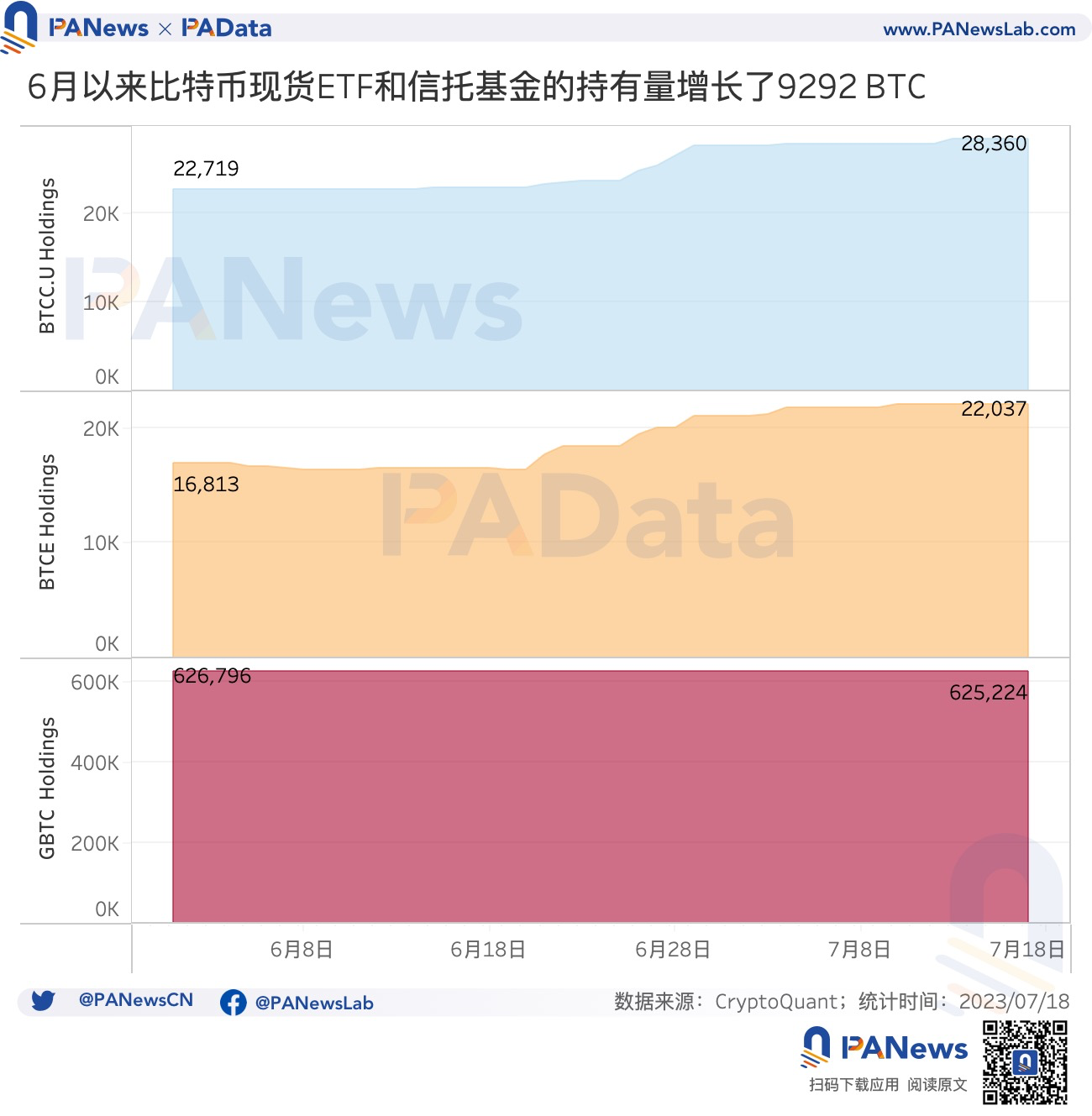
However, trust funds do not have a redemption plan, similar to paper gold, so the price will often have a significant price difference with its net asset value, but spot ETFs allow market makers to make markets, and if there is sufficient liquidity, the price will usually not A premium or discount occurs. This difference is fully reflected in the return performance of the three funds.
As of July 18, the average return of BTCC.U this month was approximately 6.76%, and the average monthly return this year was approximately 8.84%, which is significantly better than BTCE and GBTC. The average yields of the latter two this month were -5.27% and -26.39% respectively, and this years average monthly yields were -5.85% and -38.18% respectively. They are both in the red, but the magnitude of the losses has shown a shrinking trend.
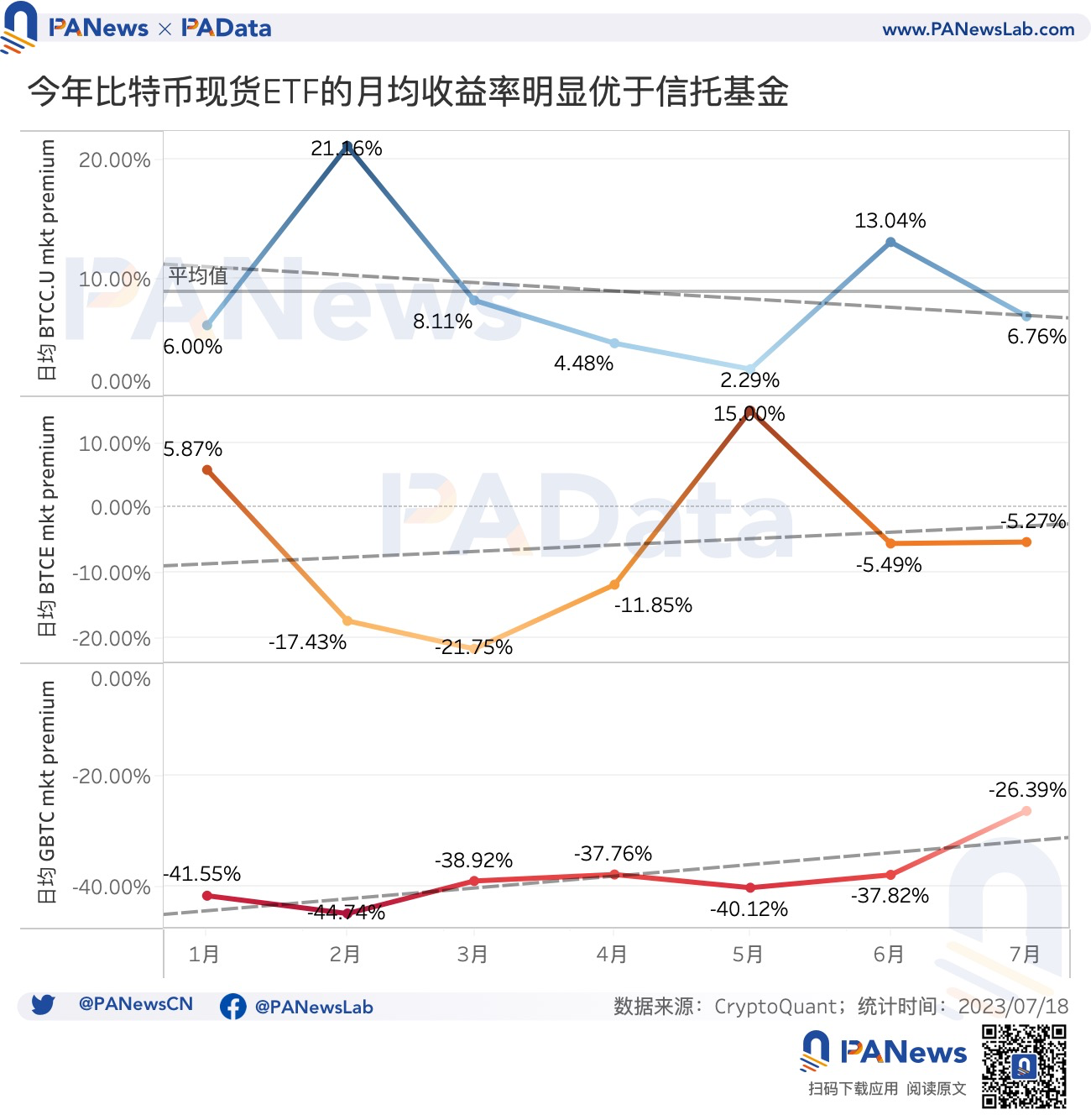
While BTCC.U’s earnings performance is better, its trading volume is not the highest. As of July 18, BTCC.U’s average daily trading volume this month was only 99,500 units, and BTCC’s average daily trading volume this month was approximately 221,700 units. The two totaled 321,200 units, which was higher than BTCE’s average of 154,000 units during the same period. copies, but lower than GBTCs average of 3.926 million copies during the same period.

However, it is worth noting that with the announcement of more institutional applications in June and the steady recovery of BTC prices, the average daily trading volume of these four funds in June increased month-on-month, among which BTCC.U increased month-on-month. 74.89%, BTCC increased by 47.27% month-on-month, BTCE increased by 23.66% month-on-month, and GBTC increased by 112.67% month-on-month. So far this month, the average daily trading volume of BTCC.U, BTCC and GBTC has continued to grow.
The total assets of the five largest Bitcoin futures ETFs are nearly US$1.3 billion, with returns exceeding 70% this year.
Although there is currently no Bitcoin spot ETF listed in the United States, there are already some futures ETFs listed in the United States. As of July 18, the total assets under management of the five major Bitcoin futures ETFs - BITO, XBTF, BTF, BITS and DEFI - have reached $1.295 billion. Among them, BITO, officially issued by ProShares in October 2021, is the largest futures ETF within statistical scope, with total assets reaching US$1.199 billion. Secondly, XBTF and BTF issued by VanEck and Valkyrie are also relatively large in size, with total assets of more than US$30 million and US$40 million respectively.
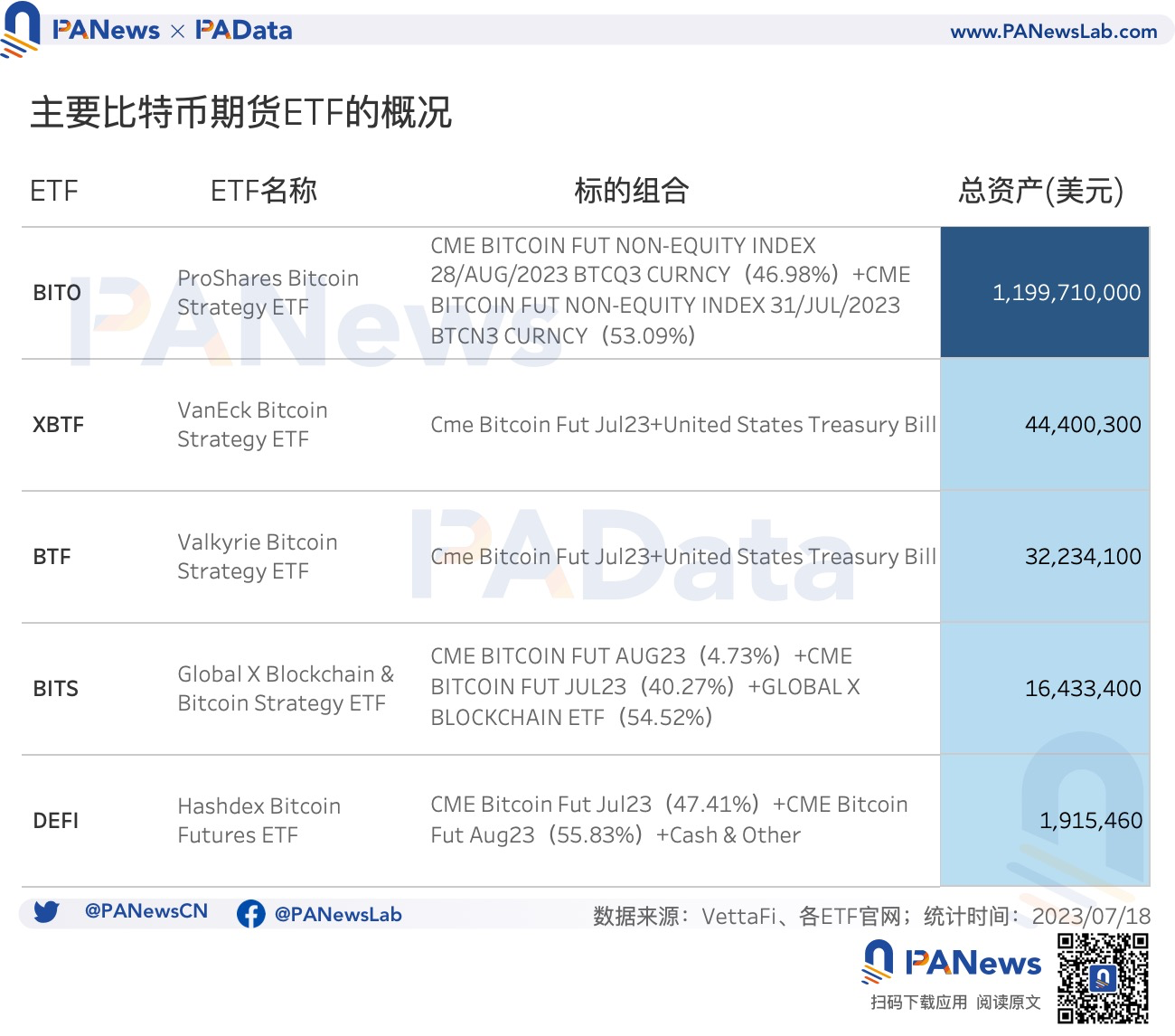
The underlying targets tracked by these Bitcoin futures ETFs are usually the Bitcoin futures contracts of the Chicago Mercantile Exchange (CME). Among them, BITO, the largest, is the only futures ETF that is fully allocated to CME futures contracts and implements a rolling futures contract strategy. In addition, other futures ETFs allocate a certain proportion of other assets on the basis of allocating CME futures contracts. For example, XBTF and BTF allocate U.S. Treasury bonds, BITS allocates blockchain ETFs issued by other institutions, and DEFI allocates cash.
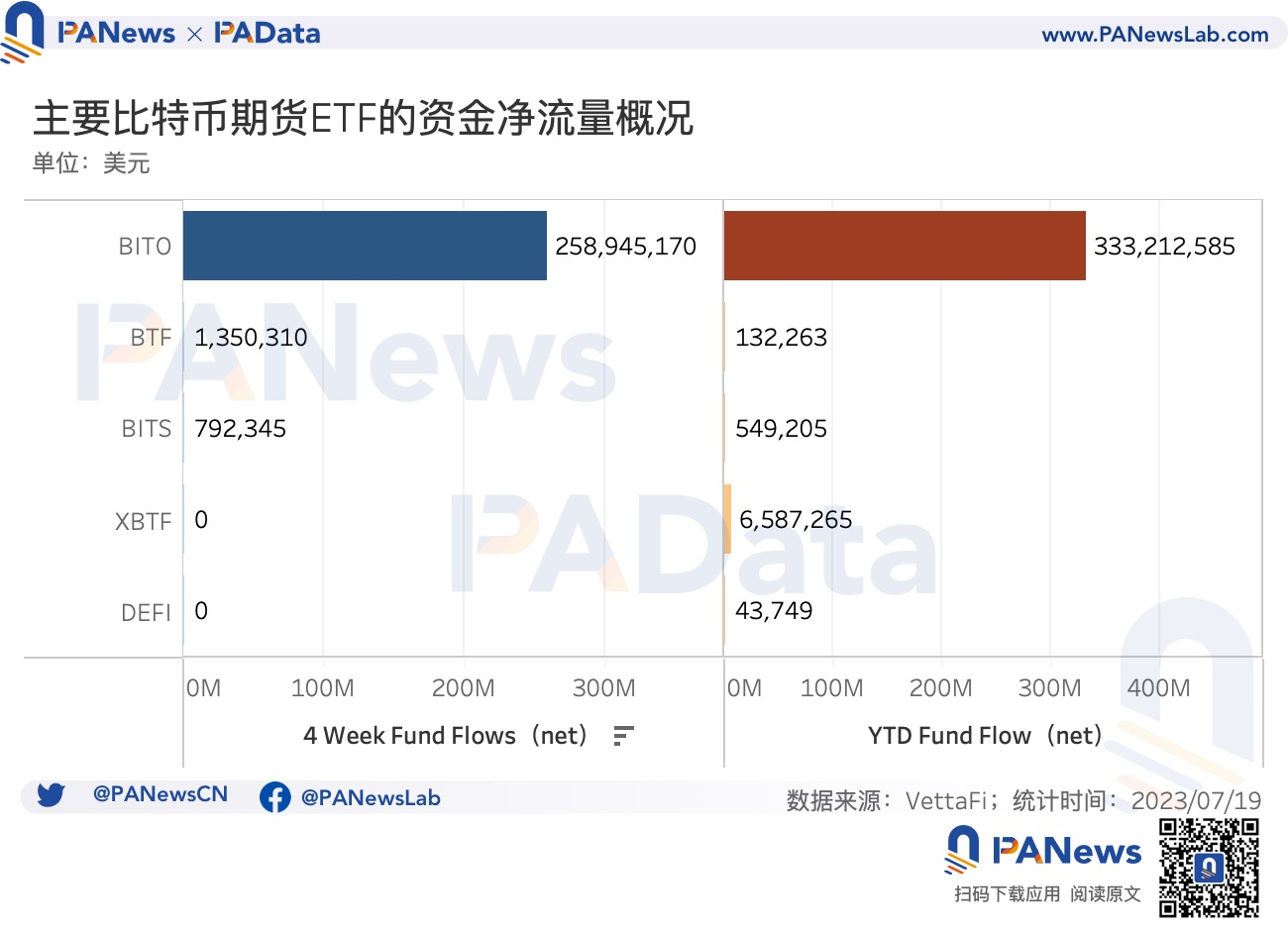
Judging from the recent net capital flows, BITO also has the largest net inflow. In the latest month, BITO saw a net inflow of $259 million. Secondly, BTF and BITS also had a small net inflow of funds in the past month, approximately US$1.35 million and US$790,000 respectively. If the time period is extended to this year, then the five Bitcoin futures ETFs within the observation range all have net inflows of funds, and the highest net inflow is still BITO, which is approximately US$333 million. Secondly, XBTF has had a net inflow of $6.58 million this year, and other ETFs have had relatively small net inflows this year.
BITO also has the highest average daily trading volume among these 5 Bitcoin futures ETFs, with approximately 9.9691 million units, exceeding 153.93% of GBTC’s average daily trading volume this month. However, the trading volume of other futures ETFs is not high. BTF is about 383,800 units, XBTF is about 17,800 units, and the remaining two are less than 10,000 units.
Overall, BITO is far ahead of other Bitcoin futures ETFs in terms of capital size, capital inflows and average daily trading volume, but in terms of returns, BITO is not ahead.
According to statistics, BITS has the highest return in the past month, reaching 33.20%, while the returns of other ETFs within the observation range are only about 12%. Even if the time period is extended to this year, BITS still has the highest return, reaching 137.65%, while the returns of other ETFs within the observation range are around 74%.

A reasonable guess is that the return rate of futures ETFs has a greater relationship with the asset exposure allocated to it. In addition to allocating Bitcoin futures contracts, BITS with the highest return rate also allocates another blockchain ETF, which points to a wider range of Crypto assets, not just Bitcoin, may provide higher yields for BITS. But in general, the return performance of Bitcoin futures ETFs is much better than spot ETFs and trust funds.
ETF news has mixed impacts on BTC prices. The recent rise in BTC prices may also be related to on-chain fundamentals.
There is no doubt that institutional entry can bring abundant funds to the crypto market, so news about institutions applying for and issuing ETFs can always drive changes in the spot price of Bitcoin. Although the impact of news is not the only reason, it is at least one of the reasons. So how big is this impact?
Based on publicly reported information, PAData counts the changes in Bitcoin spot prices within a certain time range after some ETF applications and listing news. If the public information can obtain a specific date after cross-verification, the price within a week after the news date will be counted. Changes, usually the listing news about futures ETFs can be specific to the date; if the public information can only be obtained for a specific month after cross-verification, then the price changes of the statistical news in that month, there is usually a certain ambiguity about the time of ETF application. In order to make comparisons on the same scale as possible, PAData calculated the daily average change in Bitcoin price within a certain time range, averaging over 7 days in a week and 30 days in the month.
According to statistics, within a week after the news of BlackRocks application for a Bitcoin spot ETF was announced, the spot price of Bitcoin increased by 19.49%, which is equivalent to an average daily increase of 2.78%. It is the largest average daily increase brought about by the news within the statistical scope. . This shows the market’s expectations for the entry of leading institutions.
Secondly, during GBTC’s rapid growth period (October to December 2020), the spot price of Bitcoin increased by 168.21%, equivalent to an average daily increase of 1.87%. However, within a week after GBTC was listed, the spot price of Bitcoin was only The average daily increase was 0.42%.
Other news-driven daily average increases include the VanEck Futures ETF application month, where the Bitcoin spot price rose by an average of 1.56% per day; the month when the Jacobi Spot ETF was approved, the Bitcoin spot price rose by an average of 1.33% per day; In the month of application for the Fidelity/Wise Origin and SkyBridge Capital spot ETFs, the spot price of Bitcoin increased by an average of 1% per day. In addition, there are also some news that did not drive up the price of Bitcoin. For example, on the day when news of Valkyrie’s spot ETF application was recently reported, the spot price of Bitcoin fell by 1.15%.
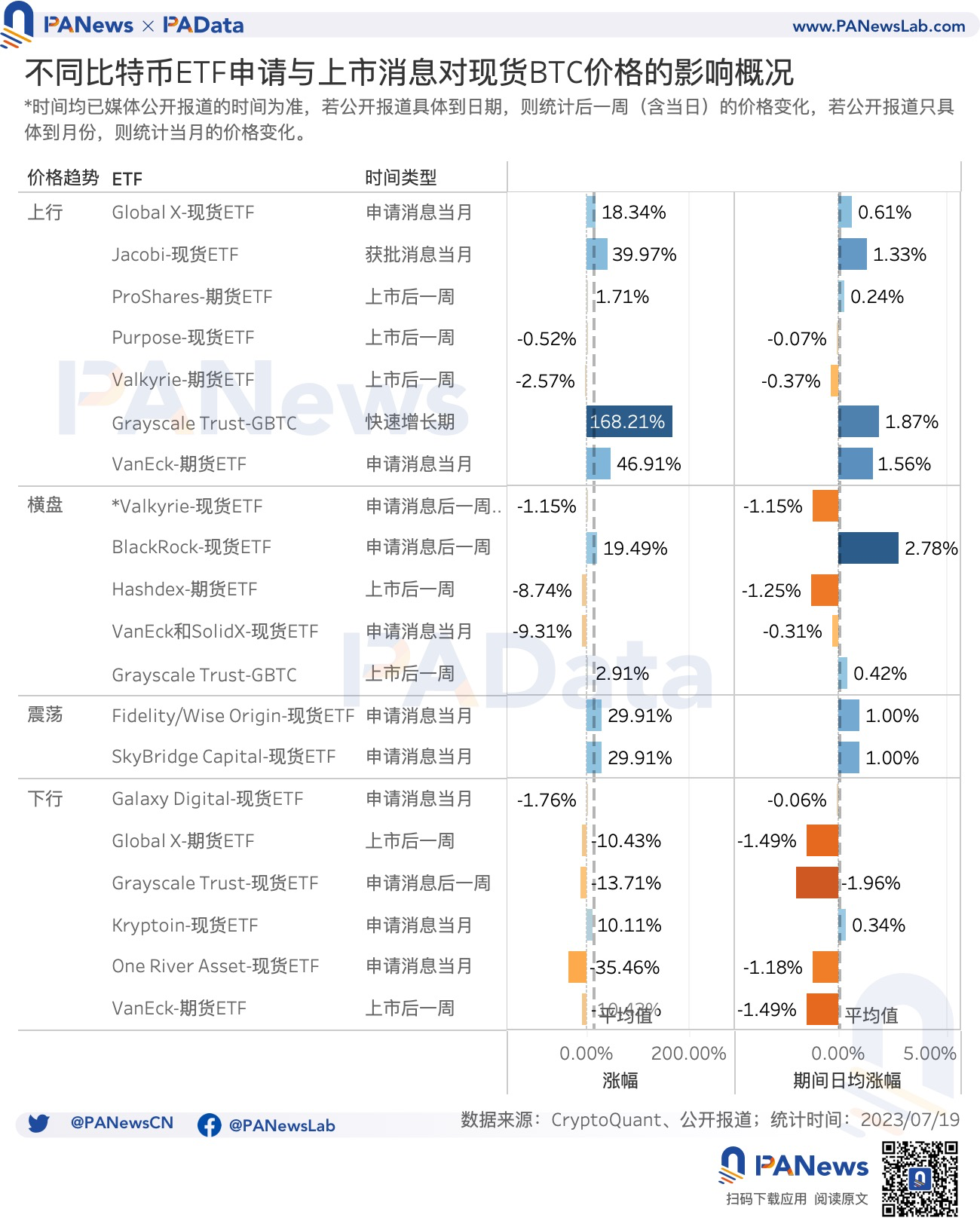
In general, the impact of institutional ETF application and listing news on Bitcoin spot prices may come from three aspects. First, the reputation endorsement of the institution itself. Institutions of the size of BlckRock, for example, can better stimulate market confidence; second, the application Among ETF types, spot ETFs face greater regulatory pressure, and none have yet been approved to be listed in the United States. Therefore, it was generally the case in the past that the application news of spot ETFs brought greater increases; third, when the news occurred , Bitcoin price trends. PAData takes the Bitcoin price when the news occurred as the midpoint, and extends it by half a year before and after to observe the Bitcoin price trend at that time. Under this rough observation, it can still be found that if the application and listing news occur during the upward trend of Bitcoin , then it can usually bring about a certain degree of price increase. If it occurs in a downward trend, then these news usually cannot reverse the market.
Therefore, it is difficult to attribute the recent rise in Bitcoin prices to one factor. In addition to the good news brought by BlckRock, it is important to note that the recent number of transactions on the Bitcoin chain has been affected by the rise of BRC-20 tokens. All time high. On July 18, the number of transactions on the Bitcoin chain reached 582,500, an increase of 210.83% from 187,400 at the beginning of the year. Judging from the trend, since May, the number of on-chain transactions has been more than 400,000 times most of the time, and there are many more than 500,000 times. The number of transactions on the chain is an intuitive reflection of the application of Bitcoin. Generally speaking, an increase in the number of transactions on the chain means that the fundamentals of transactions have improved and the price is likely to rise.
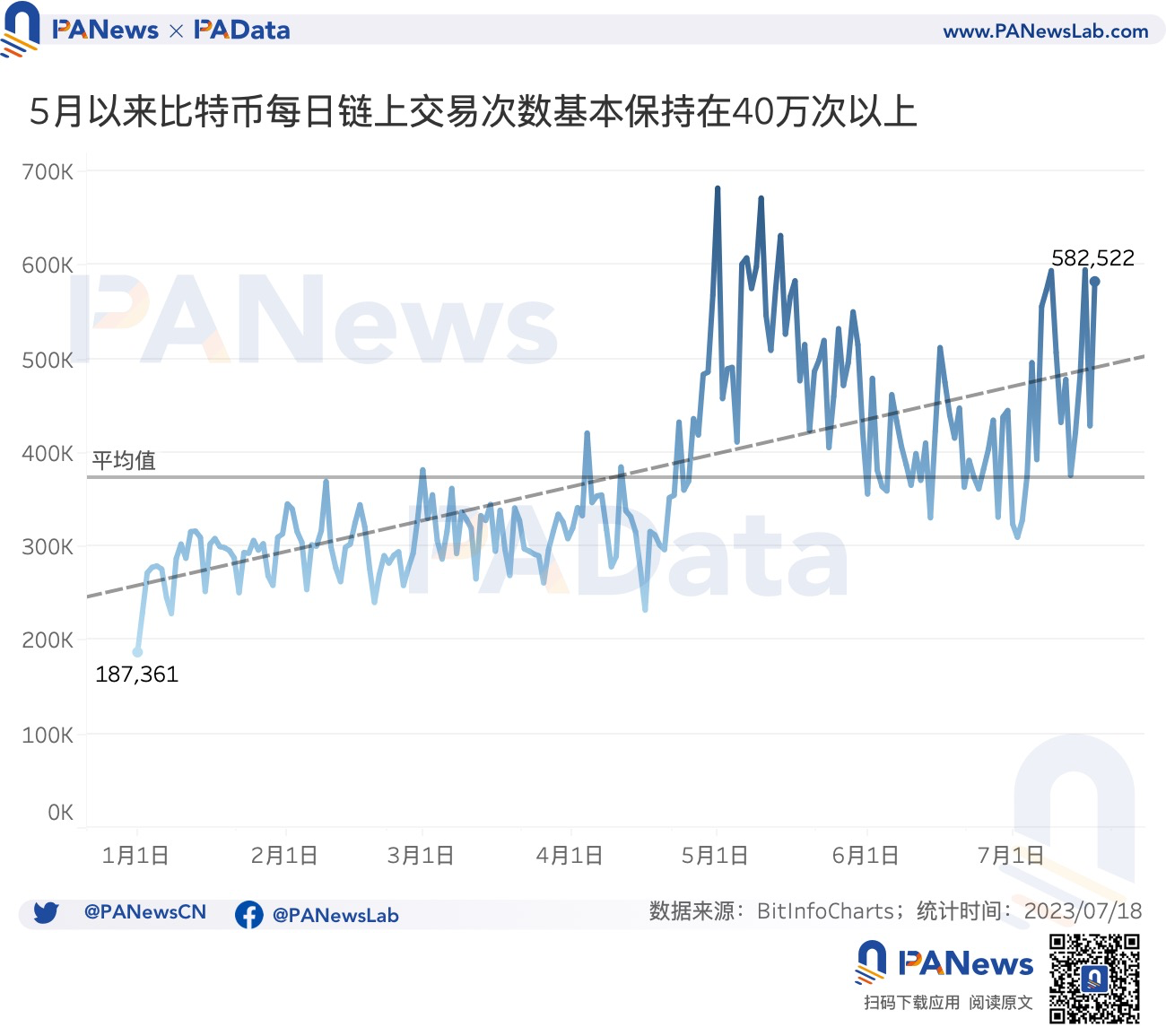
The impact of the news is complex. Whether it is spot or futures, how much funds a Bitcoin ETF can bring to the market, and how much confidence it has, depends on many factors. However, the application and approval of ETFs are inseparable from the development of the entire market, and the two should be complementary and interrelated systems. The analysis in this article only hopes to review the issued Bitcoin ETFs and observe the impact of the news to provide a basis for future analysis. On this basis, PAData will continue to pay attention to the transactions of Bitcoin ETFs.